Facing consistent and overwhelming opposition from Democrats, the ups and downs in President Trump's public standing have come primarily from independents and Republicans, particularly Republicans who are younger, female or more moderate. Trump’s approval numbers improved in 2018 along with a slightly bigger rebound in the perception that he can get things done.
Those are the most important findings from nearly a million interviews conducted in all 50 states since Trump’s inauguration by SurveyMonkey’s ongoing tracking of his presidency. While President Donald Trump’s job approval rating has been steady relative to other presidents, it has had its ups and downs over the first 15 months of his administration. It fell a bit over the first few months, leveled off, and has now ticked up again recently.
The politically curious ask, what’s behind that movement? To answer the question, we turn to nearly a million interviews conducted in all 50 states since Trump’s inauguration by SurveyMonkey’s ongoing tracking of his presidency.
Our data help understand the “why” of Trump’s approval in three ways: We can trace (1) when shifts occur, (2) whose views changed (and whose have not) and (3) how other attitudes about Trump may be adjusting along the way.
1) When: The trend in Trump approval
SurveyMonkey has been releasing weekly updates on our Trump approval tracking since February 2017. Even with a typical sample size of over ten thousand interviews each week, the results are still subject to minor fluctuations, due either to randomness in the survey process or quickly fleeting change.

Rolling the data together by month helps clarify the trend. In February 2017, 45 percent of Americans approved of the job Trump was doing as president, and 53 percent disapproved. The monthly approval rating declined gradually to 40 percent over the next six months, with the sharpest drop – a still slender 2 percentage point decline – coming in May 2017, just after Trump fired FBI director James Comey and Republicans passed a bill to “repeal and replace” President Obama’s signature health care law.

Overall Approval Shows Modest Fluctuations by Month
Trump’s approval then remained remarkably stable at 40 percent approve, 58 percent disapprove for four of the five months from August through December. At the beginning of this year, Trump’s approval rating rose two points, to 42 percent and has gradually ticked up, hitting 44 percent for the period including April and the first week of May.
Approval Intensity Ratings Gap Grows
Though the trend is similar to that of overall approval, those who strongly approve or strongly disapprove of Trump’s job performance had a sharper initial decline in strong approval, from 27 percent in February 2017 to 21 percent in August. While it has expanded and subsequently narrowed, Trump’s ratings continue to show a considerable intensity gap, with nearly twice as many now strongly disapproving of his performance (42 percent) as strongly approving (24 percent). difference is that the initial decline in strong approval, from 27 percent in February 2017 to 21 percent in August, was sharper than for overall approval.

2) Who: The shifting groups (or not)
Partisan polarization helps explain why Trump’s ratings have been relatively stable for the first 14 months of his presidency. The same pattern has repeated every month: Better than 80 percent of Republicans and independents who lean toward the GOP approve of Trump’s performance, compared with under 10 percent of Democrats and Democratic leaners. Trump’s approval is typically in the mid-thirty percent range among independents who lean to neither party.
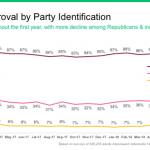
The shifts in Trump’s ratings have occurred mostly among Republicans and non-leaning independents. Both groups showed gradual declines of five to six percentage points in early 2017 and upticks in the three to four point range so far in 2018. By contrast, the movement among Democrats has been miniscule.
The relative stability in Trump’s numbers among Democrats owes to their intensity of feeling. The vast majority of Democrats (78 percent) strongly disapprove of the job he’s been doing. By comparison, slightly better than half of Republicans (55 percent) strongly approve. That intensity gap has been a constant throughout Trump’s term.
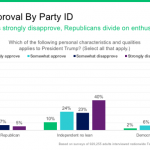
Put another way, the big overall approval numbers for Trump among Republicans masks significant divisions when it comes to the depth of their support.
Our data show subgroups of Republicans that are more hesitant in their support for the president.
First, the roughly three in 10 Republicans and Republican leaners who describe their views on politics as moderate, liberal or otherwise not conservative. Their overall approval of Trump started out 14 points lower than among conservative Republicans in February 2017, and widened to a range of between 15 and 20 percentage points ever since.
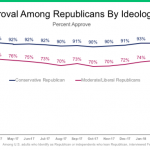
The gap between moderate and conservative Republicans who strongly approve of Trump has been even more pronounced. It started out as a 26 point gap in February 2017 and has widened slightly to 28 to 31 points over the past seven months.
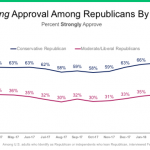
Second, younger Republicans – especially younger Republican women – are another source of softness in Trump’s approval rating. While shown a similar modest decline and rebound in his numbers over the past 14 months, the differences when it comes to strong approval among these Republican subgroups is large: Trump’s strongly approve rating is currently 64 percent among Republican men over 45, compared to just 37 percent among Republican women ages 18 to 44.
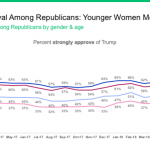
3) Other attitudes: Shifts in perceptions of Trump
Periodically, over Trump’s presidency, SurveyMonkey’s tracking surveys have asked respondents to select from a list of nine personal characteristics and qualities those they feel best apply to the president.
The trends show a slightly different pattern. As with his overall approval rating, Trump’s scores on the various characteristics declined throughout much of 2017. Since December however, the uptick on much of these traits has been smaller than the decline.
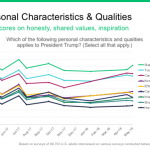
Rolling the data together into four time periods helps clarify both the rank of the various attributes and the trend. Trump’s best score, varying between 39 and 42 percent, has been on “stands up for what he believes in,” an attribute that even some of his detractors will apply. He also scores higher on “tough enough for the job” and “can get things done” than the other attributes.
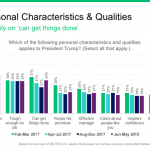
However, the trend in the individual items vary. Most show a modest decline in early 2017 that has since leveled off. The willingness to describe Trump as honest, inspirational, caring, effective as a manger or as one who shares your values all declined throughout 2017 and has not rebounded significantly so far in 2018.
Only the trait, “can get things done,” has show the same pattern of decline and rebound evident in Trump’s overall rating, but more extreme. The percentage who checked “can get things done” fell 10 points, from 37 percent in February and March 2017 to 27 percent in late 2017, and jumped back up seven points so far in 2018.
The rebound is evident among both conservative and moderate to liberal Republicans, although as with overall approval, the moderates are consistently more skeptical.
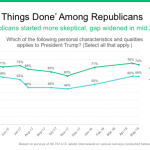
In our report on the first survey asking these questions in February 2017, we wrote that if gridlock and legislative stagnation were to follow the president’s initial flurry of executive action, his ability to “get things done" might atrophy, and with it, his overall approval rating. Something resembling that scenario played out during 2017, but has reversed since, with the passage of the Republican tax bill particularly important for the Republican identifiers.
Keep in mind that it’s mostly Republicans choosing to apply these positive characteristics to Trump. The vast majority of Democrats (78 percent) checked “none of the above” on this question, along with better than half (51 percent) of independents.
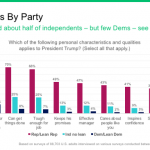
And then there’s the economy
Could Trump’s ratings uptick continue? Much of the answer depends on the continuing progress of the U.S. economy and the willingness of Americans to give Trump credit for it.
The president’s numbers have been defying gravity in one sense all along: Strong economies typically lift a president’s approval ratings, but not for Trump, at least not in his first year.
That may be changing. Approval of Trump’s handling of the economy increased from 44 percent on a survey we conducted in late May and early June 2017, to 49 percent in early May 2018. In both cases, approval of Trump on the economy slightly exceeded his overall approval.

Are Americans beginning to look past their doubts about Trump’s character?
“People have concluded that he’s a liar,” the Democratic pollster Mark Mellman told CNBC, yet “the world hasn’t come to an end…The world’s looking a little better. There’s some good news out there.”
There are obvious limits on the upward range of approval of a president who so few Americans describe as honest, caring or sharing their values. Democrats remain near monolithic in their intense opposition. Nonetheless, rising economic confidence may lift Trump’s numbers further if the good economic news continues.
Methodology: This analysis is based on 929,225 interviews of adults nationwide interviewed in SurveyMonkey tracking polls conducted continuously between February 1, 2017 and May 9, 2018. Respondents for these surveys were selected from the nearly 3 million people who take surveys on the SurveyMonkey platform each day. Data were weighted for age, race, sex, education, and geography using the Census Bureau’s American Community Survey to reflect the demographic composition of the United States. Read more about our methodology.



